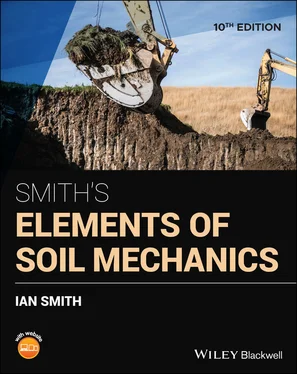1 Cover
2 Title Page
3 Copyright Page
4 Preface
5 About the Author
6 Notation Index
7 About the Companion Website
8 Part I: Fundamentals of Soil Mechanics Chapter 1: Classification and Physical Properties of Soils 1.1 Agricultural and engineering soil 1.2 The rock cycle 1.3 Clay soils 1.4 Field identification of soil 1.5 Soil classification laboratory testing 1.6 Soil classification and description 1.7 Soil properties Chapter 2: Permeability and Flow of Water in Soils 2.1 Subsurface water 2.2 Flow of water through soils 2.3 Darcy's law of saturated flow 2.4 Coefficient of permeability, k 2.5 Determination of permeability in the laboratory 2.6 Determination of permeability in the field 2.7 Approximation of coefficient of permeability 2.8 General differential equation of flow 2.9 Potential and stream functions 2.10 Flow nets 2.11 Critical flow conditions 2.12 Design of soil filters 2.13 Capillarity and unsaturated soils 2.14 Earth dams 2.15 Seepage through non‐uniform soil deposits Chapter 3: Stresses in the Ground 3.1 State of stress in a soil mass 3.2 Total stress 3.3 Pore water pressure 3.4 Effective stress 3.5 Undrained and drained conditions in a soil 3.6 Stresses induced by applied loads Chapter 4: Shear Strength of Soils 4.1 Shear strength of soil 4.2 Determination of the shear strength parameters 4.3 The pore pressure coefficients A and B 4.4 Behaviour of soil during shearing 4.5 Operative strengths of soils 4.6 Sensitivity of clays 4.7 Residual strength of soil Chapter 5: Stress Paths and the Critical State 5.1 Stress paths in two‐dimensional space 5.2 Stress paths in three‐dimensional space 5.3 Isotropic consolidation 5.4 Stress paths in the triaxial apparatus 5.5 Introduction to critical state soil mechanics 5.6 Undrained and drained planes 5.7 State boundaries 5.8 Residual and critical strength states
9 Part II: Geotechnical Codes and Standards and Site Investigation Chapter 6: Eurocode 7 6.1 Preface to Chapter 6 6.2 Introduction to the Eurocodes Section A: Eurocode 7 – first generation (EN 1997:2004 and 2007)6.3 Eurocode 7 – first generation 6.4 Geotechnical design by calculation 6.5 Ultimate limit states 6.6 The EQU limit state 6.7 The GEO limit state and design approaches 6.8 Serviceability limit states 6.9 Geotechnical design report Section B: Eurocode 7 – second generation (EN 1997: 202x)6.10 Eurocode 7 – second generation 6.11 Basis of structural and geotechnical design – EN 1990:202x 6.12 Design of a geotechnical structure – EN 1997: Parts 1, 2 and 3 (202x) 6.13 Verification by the partial factor method 6.14 Execution, Monitoring and Reporting Chapter 7: Site Investigation 7.1 Eurocode 7 and execution standards 7.2 Planning of ground investigations 7.3 Site exploration methods 7.4 Soil and rock sampling 7.5 Groundwater measurements 7.6 Field tests in soil and rock 7.7 Geotechnical reports
10 Part III: Advanced Soil Mechanics and Applications Chapter 8: Lateral Earth Pressure 8.1 Earth pressure at rest 8.2 Active and passive earth pressure 8.3 Rankine's theory: granular soils, active earth pressure 8.4 Rankine's theory: granular soils, passive earth pressure 8.5 Rankine's theory: cohesive soils 8.6 Coulomb's wedge theory: active earth pressure 8.7 Coulomb's wedge theory: passive earth pressure 8.8 Surcharges 8.9 Choice of method for determination of active pressure 8.10 Backfill material 8.11 Influence of wall yield on design 8.12 Design parameters for different soil types Chapter 9: Retaining Structures 9.1 Main types of retaining structures 9.2 Gravity walls 9.3 Embedded walls 9.4 Design of retaining structures 9.5 Design of gravity retaining walls 9.6 Design of sheet pile walls 9.7 Braced excavations 9.8 Reinforced soil 9.9 Soil nailing Chapter 10: Bearing Capacity and Shallow Foundations Design 10.1 Bearing capacity terms 10.2 Types of foundation 10.3 Ultimate bearing capacity of a foundation 10.4 Determination of the safe bearing capacity 10.5 The effect of groundwater on bearing capacity 10.6 Developments in bearing capacity equations 10.7 Designing spread foundations to Eurocode 7 (first generation) 10.8 Designing spread foundations to Eurocode 7 (second generation) 10.9 Non‐homogeneous soil conditions 10.10 Estimates of bearing capacity from in situ testing Chapter 11: Pile Foundations 11.1 Introduction 11.2 Classification of piles 11.3 Method of installation 11.4 Pile load testing 11.5 Determination of the bearing resistance of a pile 11.6 Pile groups 11.7 Designing pile foundations to Eurocode 7 (first generation) 11.8 Designing pile foundations to Eurocode 7 (second generation) 11.9 Piles subjected to additional, non‐compressive loadings Exercises Chapter 12: Foundation Settlement and Soil Compression 12.1 Settlement of a foundation 12.2 Immediate settlement 12.3 Consolidation settlement 12.4 Application of consolidation test results 12.5 General consolidation 12.6 Settlement analysis 12.7 Eurocode 7 serviceability limit state 12.8 Stress paths in the oedometer 12.9 Stress path for general consolidation Chapter 13: Rate of Foundation Settlement 13.1 Analogy of consolidation settlement 13.2 Distribution of the initial excess pore pressure, u i 13.3 Terzaghi's theory of consolidation 13.4 Average degree of consolidation 13.5 Drainage path length 13.6 Determination of the coefficient of consolidation, c v, from the consolidation test 13.7 Determination of the permeability coefficient from the consolidation test 13.8 Determination of the consolidation coefficient from the triaxial test 13.9 The model law of consolidation 13.10 Consolidation during construction 13.11 Consolidation by drainage in two and three dimensions 13.12 Numerical determination of consolidation rates 13.13 Construction pore pressures in an earth dam 13.14 Numerical solutions for two‐ and three‐ dimensional consolidation 13.15 Wick, or prefabricated vertical, drains 13.16 Preconsolidation by surface loading Chapter 14: Stability of Slopes 14.1 Planar failures 14.2 Rotational failures 14.3 Slope stability design charts 14.4 Wedge failure 14.5 Slope stability assessment to Eurocode 7 Chapter 15: Soil Compaction, Highway Foundation Design and Ground Improvement 15.1 Field compaction of soils 15.2 Laboratory compaction of soils 15.3 Specification of the field compacted density 15.4 Field measurement tests 15.5 Highway design 15.6 Subgrade improvement through soil stabilisation 15.7 The moisture condition value, MCV 15.8 Ground improvement techniques 15.9 Environmental geotechnics Chapter 16: An Introduction to Constitutive Modelling in Geomechanics 16.1 Introduction 16.2 Stress‐strain behaviour 16.3 Selecting the most appropriate constitutive model 16.4 Linear elasticity theory 16.5 Rigid plasticity theory 16.6 Elastoplasticity theory
11 References
12 Index
13 End User License Agreement
1 Chapter 1 Table 1.1 Particle size limits for different soil fractions. Table 1.2 Shape of grading curve. Table 1.3 Principles of soil classification.
2 Chapter 4Table 4.1 Compression of saturated soils.Table 4.2 Undrained shear strength of clays.Table 4.3 Sensitivity classification.
3 Chapter 6Table 6.1 Partial factor sets for EQU, GEO and STR limit states.Table 6.2 Definition of consequence classes.Table 6.3 Applicability of design cases in geotechnical design.Table 6.4 Geotechnical complexity class.Table 6.5 Relationships between geotechnical categories, consequences classes...Table 6.6 Partial factors on actions and effects for persistent and transient...Table 6.7 Partial factors on ground properties for persistent and transient d...Table 6.8 Consequence factors K Mfor materials in geotechnical structures.Table 6.9 Partial factors for the verification of ground resistance of spread...Table 6.10 Execution standards referred to in EN 1997‐3:202x.
Читать дальше












